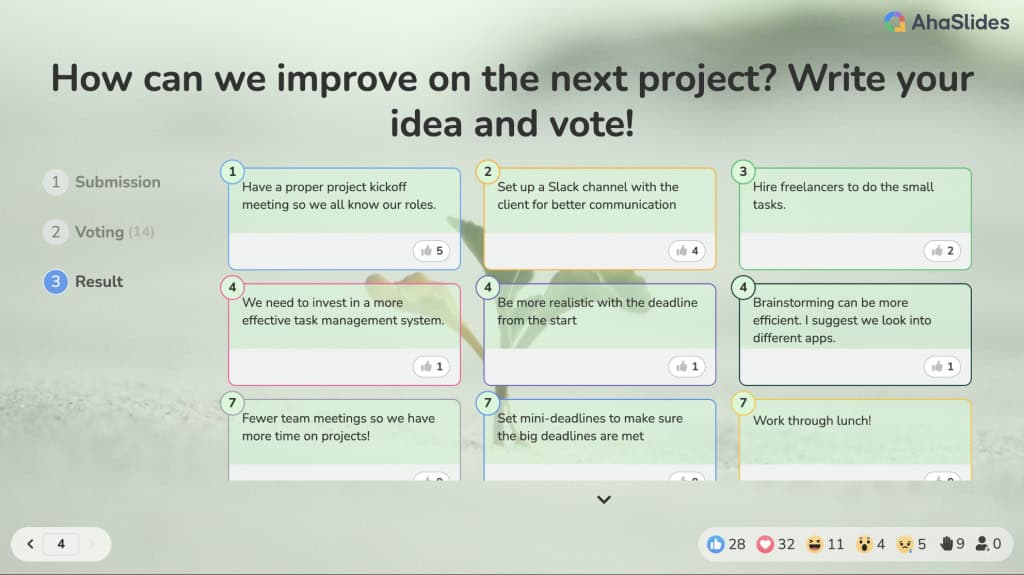Да ли сте икада завршили пројекат са осећањем да је нешто могло да прође боље? Или си га можда разбио из парка, али не можеш да ставиш прст зашто? Ето где ретроспективе пројекта Уђите. Они су као извештај за ваш тим, шанса да прославите победе, научите из штуцања и поставите сцену за још већи успех у будућности.
Шта је ретроспектива пројекта?
Ретроспектива пројекта, која се понекад назива ретроспективни састанак, ретроспективна сесија или једноставно ретро, је посвећено време за ваш тим да размисли о пројекту након његовог завршетка (или на кључним прекретницама). То је структурирани осврт на цео животни циклус пројекта – добро, лоше и „могло би бити боље“.
Размислите о томе овако: замислите да је ваш пројекат путовање. Ретроспектива је ваша шанса да се након тога окупите око мапе, пратите своју руту, истакнете сликовите видике (те сјајне победе!), идентификујете неравне путеве (ти досадни изазови) и планирате лакше руте за будућа путовања.
Како ефикасно водити ретроспективу
У реду, хајде да исечемо пух и скочимо право у њега како водити ретроспективни састанак који заправо даје резултате. Ево једноставног оквира:
Корак 1: Поставите позорницу и прикупите повратне информације
Агенда. Сваки састанак, ретроспективан или не, захтева дневни ред. Без тога бисмо били јелен у фаровима, не знајући одакле да скочимо. Јасно дефинисати значење и циљеве ретроспективног састанка. Створите безбедно и отворено окружење у коме се сви осећају пријатно да деле своје мисли. Постоје неки популарни ретроспективни формати које можете пратити, као што су:
Старт - Стоп - Настави:
📈 Почетак "Шта да почнемо да радимо?"
- Нове идеје вредне покушаја
- Недостају процеси који су нам потребни
- Могућности за унапређење
- Свежи приступи за разматрање
🛑 Стоп „Шта да престанемо да радимо?“
- Неефикасне праксе
- Активности које губе време
- Контрапродуктивне навике
- Ствари које нас успоравају
✅ Наставити „Шта добро функционише што би требало да наставимо да радимо?“
- Успешне праксе
- Ефикасни токови посла
- Позитивно понашање тима
- Ствари које доносе резултате
Добро је прошао – побољшати – Акционе ставке:
✨ Прошао добро „Шта нас је учинило поносним?
- Главна достигнућа
- Успешни приступи
- Тим побеђује
- Позитивни исходи
- Ефикасна сарадња
🎯 Побољшати „Где можемо боље?“
- Тачке бола које треба адресирати
- Пропуштене прилике
- Уска грла процеса
- Комуникациони недостаци
- Изазови ресурса
⚡ Предмети акције „Које ћемо конкретне кораке предузети?
- Јасни, изводљиви задаци
- Додељене одговорности
- Обавезе на временској линији
- Мерљиви циљеви
- Планови за праћење
Нека сви разговарају уз АхаСлидесове анонимне анкете, облаке речи, питања и одговоре уживо и гласање у реалном времену
▶ Ево кратког водича за почетак: Пријавите се за АхаСлидес, изаберите ретро шаблон, прилагодите га својим потребама и поделите са својим тимом. Лако-пеаси!

Корак 2: Анализирајте, размислите и генеришете увиде који могу да делују
Када се повратне информације прикупе, време је да се идентификују кључне теме и обрасци у повратним информацијама. Које су биле највеће победе? Који су били главни изазови? Где су ствари скренуле са колосека? Групирајте исте теме како бисте трансформисали запажања у конкретне акције. Завршите то акцијом:
- Гласајте о приоритетним ставкама
- Доделите одговорности
- Поставите временске оквире
- Планирајте праћење
Када би требало да одржите ретроспективу пројекта?
Тајминг је кључан! Иако се ретро пројекат често одржава након завршетка пројекта, немојте се ограничавати. Размотрите ове сценарије:
- Крај фазе пројекта: Спровести ретроспективно управљање пројектима сесије на крају главних фаза за рано исправљање курса.
- Редовни интервали: За дугорочне пројекте, распоредите редовно ретро сесије, као што су недељно, двонедељно, месечно или тромесечно, да би се одржао замах и брзо решили проблеми. Ово посебно одговара тимовима који нису производи као што су маркетинг и ЦС одељења.
- После критичног инцидента: Ако пројекат наиђе на значајан изазов или застој, а ретроспективни састанак може помоћи у разумевању основног узрока и спречити понављање.
Које су главне сврхе одржавања ретроспективе?
Ретроспективе у управљању пројектима су од виталног значаја за континуирано побољшање. Они нуде сигуран простор за искрене повратне информације, помажући тимовима:
- Идентификујте шта је функционисало добро, а шта није. Ово је срж сваког ретроспективни пројекат. Анализом успеха и неуспеха, тимови стичу вредне увиде за будуће пројекте.
- Откријте скривене препреке. Понекад проблеми тињају испод површине. Тим ретро изнети их на видело, омогућавајући проактивно решавање проблема.
- Повећајте морал тима и сарадњу. Прослављање победа и признавање доприноса свих подстиче позитивно тимско окружење.
- Покрени континуирано учење и развој. Ретро подстичу начин размишљања о расту, где се учење на грешкама посматра као пут ка побољшању.
- Побољшајте будуће планирање и извршење. Анализом прошлих перформанси, тимови могу побољшати своје процесе и поставити реална очекивања за будуће пројекте.
Запамтите, циљ није да се задржавате на грешкама, већ да учите из њих. Продуктивна ретроспективна сесија управљања пројектима у којој се сви осећају саслушани, цењени и мотивисани допринеће култури континуираног учења и раста.
Идеје за сјајну ретроспективу пројекта
Традиционални ретро понекад може изгледати устајало и непродуктивно. Али са АхаСлидес-ом можете:
1. Нека сви отворе
- Анонимно гласање за искрене повратне информације
- Облаци речи за колективно размишљање
- Питања и одговори уживо која свима дају глас
- Гласање у реалном времену ради одређивања приоритета проблема
2. Нека буде забавно
- Брзи квизови за преглед прекретница пројекта: „Присетимо се наших кључних прекретница!“
- Анкета Ледоломца да пробуди сваки ум: „У једном емоџију, шта мислите о пројекту?“
- Колаборативне табле за размишљање о тимским идејама
- Реакције уживо за тренутне повратне информације
3. Лако пратите напредак
- Прикупљање визуелних података
- Резултати који се могу извести
- Сажеци који се лако деле









